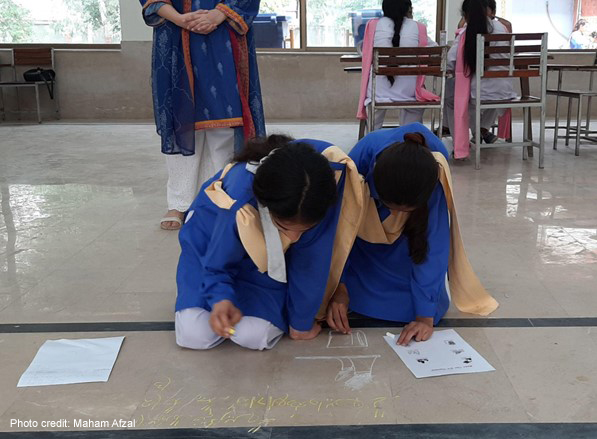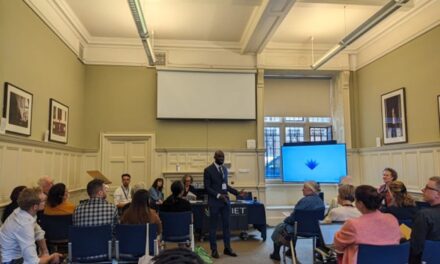This blog was written by Dr Razia Iram Sadik, Associate Professor at the Syed Maratib Ali School of Education, Lahore University of Management Sciences, and Maham Afzal, an alumna of MPhil Education Leadership and Management, School of Education, Lahore University of Management Sciences. The blog is based on a presentation given at the UKFIET 2023 conference.[i]
Green school programmes take on various forms and names worldwide, but at their core, they embrace a “whole school approach“. This approach seeks to involve students, educators, and the local community to enhance the school environment and inspire students to identify and address environmental issues at the local level (Bolstad, Baker, Barker & Keown, et al., 2004). Andreou (2020) states that by emphasising community engagement and the adaptability of the approach to local circumstances and requirements, the “whole-school” approach to environmental education offers a framework for schools to serve as models of sustainability within their communities.
In Pakistan, despite the country’s adoption of the UN’s Agenda 21, environmental education primarily consists of surface-level coverage of topics like energy, pollution, and recycling in the science curriculum for primary and secondary classes (Dhindsa, 2016). Regrettably, the curriculum lacks the integration of concepts and fails to provide teachers with guidelines to create activities that engage students in developing environmentally-conscious behaviours and attitudes (Dhindsa, 2016; Khanum, 2019). While Pakistan initiated the Coordinated Environmental Education Project (CEEP) from 1989 to 1992 to train teachers, government officials, and decision-makers, the actual progress of environmental education in Pakistan is fragmented, with various NGOs and INGOs, such as WWF-Pakistan, leading localised initiatives in different regions of the country (Dhindsa, 2016; Qureshi, Qureshi, and Shah, 2017).
To ensure that environmental education initiatives yield tangible outcomes, leading to students internalising sustainable practices that extend beyond the confines of the classroom, the pedagogical approach must transcend the mere memorisation of curriculum content. However, achieving this transformation in practice proves to be a formidable challenge. Teachers often operate within an education system burdened by unrealistic demands and expectations, predominantly relying on prescribed textbooks to deliver the curriculum and following a fixed examination pattern.
Amid this landscape, our pilot study’s design examined the efficacy of Visible Thinking Routines, an interactive metacognitive teaching and learning approach, which we harnessed towards solidifying students’ environmental knowledge. Visible Thinking Routines represent a low-cost, efficient, and user-friendly instructional method that enables educators to convey content to students in a manner that extends their learning outside the classroom in a relatively short time.
Visible Thinking is a research-based educational approach developed by Harvard University’s Project Zero research centre in the early 2000s during a study on student dispositions and classroom culture (Ritchart, Church, and Morrison, 2011). It is a versatile yet structured methodology that connects students’ thinking with their learning by making their thought processes observable. It involves a series of communication steps initiated by a teacher or facilitator in a classroom or other learning environment to engage with subject matter knowledge actively within a brief timeframe.
Central to the concept of Visible Thinking is the notion of cognitive flexibility. This recognises that thinking approaches can vary and exhibit potential adaptability (‘buoyancy’) among students, emphasising the importance of affording them the opportunity to express their thoughts in a flexible manner. Research on Visible Thinking demonstrates that this method of promoting understanding is more likely to extend students’ comprehension to real-life situations beyond the classroom, as it activates their cognitive dispositions (Project Zero website; Ritchart, Turner, and Hadar, 2009) toward specific subject matter knowledge, attitudes or topics. Cognitive dispositions represent ingrained thinking patterns that become habitual for students, thus equipping them with robust knowledge related to a particular subject matter in the context of real-life applications.
Our pilot study was a small-scale exploration of the effectiveness of Visible Thinking Routines as a medium to embed sustainable environmental education practices within classrooms. Instead of concentrating solely on materials, the study emphasised the development of understanding and long-lasting results, using teachers and students as catalysts to raise awareness and potentially develop pro-environmental behaviours in schools and the wider community. To achieve this, the study followed WWF’s seven-step ecological education approach, known internationally for such programmes. The study was intended to create a robust, holistic instructional plan through an intense, condensed teacher training programme and Environmental Club sessions in schools with children from Grades 5 to 7.
The goals of this pilot study encompassed three key areas: pedagogical, evaluative and policy-building. Pedagogically, the study aimed to contribute to the establishment of a baseline Green Schools Certification programme in five public schools in Lahore, crafting an interactive instructional design that accommodated diverse school contexts and effectively training teachers and administrators for its delivery. During the evaluative phase, the study sought to comprehensively assess the programme’s strengths and weaknesses through an evaluation study, utilising pedagogical artifacts as data. Lastly, the study also formulated a policy brief for Green Schools Certification to be considered by the Government of Punjab, with the ultimate goal of mandating its implementation across all schools in the province, facilitating the widespread adoption of ethical environmental education practices.
Some of the most prominent findings of the study are discussed below:
Teacher motivation and commitment
Teacher motivation and commitment emerged as influential factors in determining the quality of students’ learning experiences. Schools with highly motivated and eager teachers fostered positive learning environments that likely contributed to improved student outcomes. Conversely, some schools exhibited lower levels of teacher motivation, which may have hindered student engagement and comprehension.
Teacher qualifications
Interestingly, the qualifications and backgrounds of lead teachers played a role in shaping the teaching approach. Despite variations in academic backgrounds, the commitment among educators and students cultivated encouraging learning environments. Furthermore, teachers with an arts and humanities background exhibited greater creativity and were more open to collaborative and exploratory elements within the Visible Thinking Routines. Not only that, but their motivation levels were also significantly higher as compared to their counterparts.
Gender dynamics
Gender dynamics also played a role, with certain school environments demonstrating higher motivation and engagement among female students. In Pakistan’s public schools, the gender of teachers is segregated by the gender of the school, i.e. women teach in girls schools and men in boys. These environments appeared more conducive to nurturing students’ interest in environmental topics. In contrast, some schools faced challenges related to teacher motivation and engagement, possibly reflecting distinct dynamics within these contexts.
Systemic challenges
Complaints from teaching staff about inadequate facilities and other systemic challenges, such as availability of time, and inconsistency in teacher professional development, shed light on the broader institutional and political context of public education in Pakistan. In general, these challenges significantly impede the teaching and learning process, limiting students’ opportunities to fully engage with environmental topics, across the country. This raises the important and ultimately unavoidable role of school cultures and the core curriculum as major potential players in meaningful and sustained learning about the environment throughout a child’s school journey.
Religion-derived ethical standards
Religion-derived ethical standards emerged as a major driver for motivating both students and teachers to consider environmental knowledge and action. These ethical principles likely provided a strong foundation for instilling environmental values and fostering a sense of responsibility among students and educators. While some of the beliefs and reasoning behind the core environment and climate-related problems, such as air and water pollution, lacked scientific reasoning, the researchers saw this as an opportunity to introduce scientifically-validated environmental knowledge through the process of using Visible Thinking Routines. As the teaching approach elicits opportunities to raise questions, it provided the research team the opportunity to debunk certain myths about the reasoning behind environmental phenomena, among both students and teachers.
School resources and engagement
While the vast majority of public schools are low-resourced in Pakistan, there is usually a spectrum of resource access, as was the case in our sample schools. However, interestingly, there was no strong correlation between the availability of school resources and the levels of student and teacher engagement. This suggests that while resources are essential, they are not the sole determinant of engagement while using Visible Thinking Routines. Other factors, such as teacher motivation and leadership, played equally crucial roles.
Overall satisfaction and sense of urgency
Overall, there was strong evidence of satisfaction among both students and teachers with the pedagogical approach due to its emphasis on interaction and collaboration among students. Our Visible Thinking Routines for environmental education provided opportunities for student agency and voice, its fun elements kept the dialogue light-hearted on a serious subject such as the environment and its arts-based approaches – use of drawing, pictures, comic book format of the workbooks, Nature Diaries – kept students’ interest elevated. Overall, the approach appeared to increase students’ awareness, interest and engagement about the urgency regarding climate change.
Limitations of the pilot study
As researchers, we reflected hard on the various pedagogical decisions taken during the intervention and would recommend a stronger connection between the Visible Thinking Routines employed in the Eco Club sessions and the Nature Diaries workbooks the students were given, to carry out easy, fun environmental experiments geared towards learning the scientific reasoning behind environmental problems. In our pilot, while we utilised the Nature Diaries as a means of connecting the Eco Clubs’ sessions with their after-school lives, the depth of the instrument could be reconsidered both scientifically and pedagogically.
Final recommendations and lessons learned
Reinforcement and continual incorporation of Thinking Routines throughout the curriculum is vital to establish them as second nature for both students and educators. It is essential to create a blended pedagogy that integrates Thinking Routines with other proactive methods, such as place-based learning, psycho-geographic approaches to learning about our surroundings and learning through affect. The curriculum should also place a stronger emphasis on acknowledging the geographic context in environmental themes.
On the pedagogical front, the evidence from our study strongly suggests that there is a need to provide ongoing professional development opportunities for teachers, particularly focusing on climate management and education for teachers of all subjects, as well as school administrators at various levels, making it part of the organisational ecosystem of a school. Moreover, teacher capacity development should prioritise climate justice and climate action, fostering a transformation towards pro-environmental behaviours. Lastly, but most importantly, expanding the circle of stakeholders is essential for formulating provincial policy recommendations grounded in scientific rigour, cultural and geographical relevance, and a sustainable, community-driven advocacy strategy across all types of public and private schools.
[i] This study was funded by the Office of Research, Lahore University of Management Sciences, Pakistan under its Faculty Initiative Fund.





